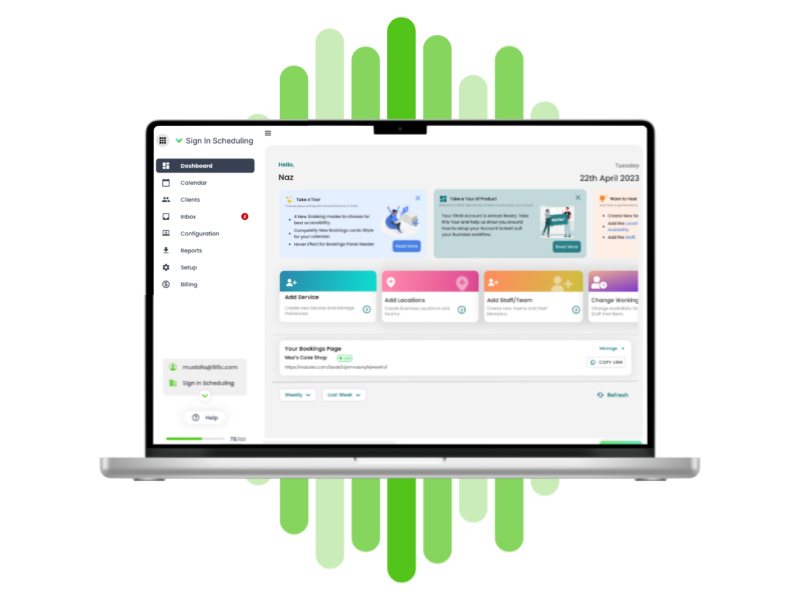Do you want to run a successful virtual classroom? Whether you’re new to online teaching or you’ve...
How to Utilize Technology to Increase Student Engagement
Technology is everywhere. We use it at home, in the office, and even to keep up with friends or family. The same can be said for how we learn.
Technology has changed the way we absorb information and as a result, it has changed the way teachers teach. With more people utilizing technology in their everyday lives, it is only natural that education and student engagement would follow suit – for instance, you’re reading this article because of technology!
There are now lots of ways that educators can combine technology and student engagement. Technologies such as computer-based instruction, online learning platforms, and virtual reality can all be used in education. With these new methods on the rise, teachers need to know how they can incorporate them into their teaching practices and help students learn more effectively.
So, whether you’re looking for fun educational tools, or simply need online tutoring software to ease some of your admin work, we’ve decided to explore some of the best ways of engaging students with technology. Here’s what you can do as an educator to bring a more modern twist to your classroom.
Let's take a look at...
- How technology effects student engagement;
- The difference between participation and engagement;
- How to use technology to motivate students;
- How to combine technology and student engagement;
- What the best student engagement platforms are for universities;
- Whether smart technology can boost engagement in higher education.
How does technology affect student engagement?
There is no one answer to this question as technology can have a multitude of effects on education. However, there are some general ways in which technology can impact teaching and learning.
For example, when used appropriately, technology can help teachers become more efficient by speeding up and simplifying lesson plans. Technology can help students learn new concepts quicker, as well as help them retain that information better. It also breaks down the barriers between teachers and students, making the learning process more engaging for students, as well as allowing them to work from outside of the four walls of a classroom, such as at home.
Furthermore, tech can encourage collaboration, and it can provide students with more exposure to a variety of people and ideas. Using technology, you can connect two students from across the world, which is a great and authentic way to teach them about other cultures.
It can also allow educators to curate tasks to meet the needs of each individual student. With a well-equipped classroom, all students can be working on different assignments at their own level and pace. This helps ensure that all students are able to learn in an environment that is best suited to their needs.
Finally, tech can be used to eliminate a lot of the admin-based tasks that teachers face. For example, booking appointments with students if you’re an online private teacher can all be done via an online booking system like 10to8 which will allow students to schedule their own classes.
These are just some of the reasons why teachers across all grade levels are now using technology to streamline their lessons and maximize student learning experiences.
What’s the difference between participation and engagement?
When it comes to teaching, it is important to understand the difference between participation and engagement. Participation refers to how much a student is involved in an activity, whereas engagement reflects how interested and focused students are in what they are doing.
It’s easy for educators to assume that if students are participating in-class activities, they are also engaged in the learning process. However, this is not always the case.
In order to truly maximize student engagement with technology and education, it’s important that teachers know how to identify whether or not their students are actually engaging with what they are doing in class instead of just participating for a grade. And when it comes to using technology, in today’s modern age, it tends to fuel more engagement than traditional teaching methods.
How can teachers measure student engagement?
There are a few simple ways for educators to identify whether or not their students are engaged in the learning process.
![]()
For starters, keep an eye on how long your students are paying attention to digital devices or other technology in class. Are they using it to supplement their learning, or is it becoming a distraction? If the use of technology is taking away from the engagement of students, then it’s time to rethink how and when you are incorporating technology into your lessons.
It can also be helpful to ask students directly how engaged they feel in class. Ask them to share examples of activities that have kept them interested and motivated, as well as those that haven’t. This can help you get a better idea of what types of technology work best for your students and the subjects you are teaching.
How can technology be used to motivate students?
When it comes to motivating students, technology can be used in a variety of ways.
For example, when you are looking for new ways to motivate your own students or kids that you work with tutoring or coaching outside the classroom, try using digital classroom tools like Google Classroom or Blackboard Collaborate. These websites provide a variety of features that can be used to supplement classroom learning or help students learn outside of the traditional school setting.
In addition, many teachers are using online tools like Proprofs Quiz Maker to create fun, interactive quizzes, and games for their students. These tools are especially great for increasing student engagement in STEM subjects.
Another way to use technology more effectively is by incorporating digital simulations into your lessons, as well as virtual field trips and online resources that encourage students to learn about different cultures from around the world.
How to combine technology and student engagement
So, how can teachers engage students with technology in their classrooms? Well, here are a few ideas:
Turn learning into a game
Making learning fun is a great way to keep students engaged, and using games is one of the easiest ways to do this. There are a variety of online games that teachers can use to create fun learning activities for their students, including virtual Trivia, virtual Pictionary, or even virtual Musical Chairs! You can find these through education-based games tools like Kahoot! And, as well as being super fun, they will go a long way to keeping students engaged in your lessons.
Interactive videos
Another way to blend technology and student engagement is by using interactive videos. These videos utilize different types of media, such as text, audio, and video clips, to engage students with a topic or story that they might otherwise be uninterested in.
EdX, Future Learn, and Amazon Education are all great websites for finding engaging educational videos that can also be used for homework or in-class activities. For creating your own videos, try tools like EdPuzzle.
Online quizzes
Quizzes are another great way to engage students with technology. They can be used to test student understanding of a topic, or as a review activity before a big test. There are a variety of online quiz tools that teachers can use, including Proprofs Quiz Maker.
Websites like this allow you to create interactive quizzes that can be taken and shared with students via a classroom webpage or Google Classroom.
Podcast learning
Podcasts can be a great way to promote student engagement and make learning more fun, especially for struggling learners.
Podcasts can be used as supplemental content or listening activities in the classroom, and there are many podcasts that cover educational topics like Mr. Barton Maths Podcast. These can be very useful for students who learn quicker from listening than reading.
There are also podcasts designed specifically for teachers to inspire more creative learning. A great example of this is The Teaching Space.
Virtual classroom tools
Tools like Google Classroom and Edmodo can be used to create a virtual classroom for your students. This allows you to post assignments, readings, and videos for your class online, as well as communicate with your students electronically.
Virtual classrooms also give students the opportunity to complete and turn in their work online, which can be helpful for teachers who are looking to go paperless.
Technology-based assignments
Instead of submitting paper assignments and asking for homework to be handed in on a piece of A4, virtual assignments are great for engaging students and making learning more fun. These can include any type of assignment that involves using technology in some way, whether it is by creating a presentation with Google Slides or more unique methods like building something on Minecraft Edu. These types of activities allow students to learn new skills while also allowing you as the teacher to assess their knowledge and understanding of the material.
In addition, they can be used as a way to engage students who might struggle with traditional assignments, which is always beneficial for learners that need additional support in the classroom.
Once students have completed a lot of digital projects, you can also create digital portfolios of your student’s work. These are great ways to give parents an inside look at what is going on in the classroom.
Virtual training videos
Virtual training videos are another great way to use technology in the classroom. These can include online tutorials or how-to guides on any type of educational topic.
Whether you want to use training videos to help students learn a new language, or even to solve complicated math problems, these types of videos can be very beneficial for student engagement.
You can use training videos as supplemental content in the classroom, or they can be assigned as homework to help students learn a topic in more depth.
Use productivity apps and tools
There are a number of productivity apps and tools that can be used in the classroom to help students stay organized and on track. These apps often include features like timers, checklists, and notifications that can help teachers keep their students on track.
Some popular productivity and project management apps for students include Asana, Evernote, and iHomework 2. But when it comes to using tech tools in the classroom, there are many options to choose from.
Use virtual and augmented reality
Virtual and augmented reality is becoming more and more popular in schools, and for good reason. These technologies allow students to immerse themselves in a digital environment, which can be helpful for learning new information or practicing skills.
There are many different virtual reality (VR) and augmented reality (AR) apps and tools that teachers can use in the classroom, and the best way to find out which ones work best for you is to experiment. Some popular VR/AR apps that are used in schools include Google Expeditions and Nearpod VR.
Use student response systems
Gathering feedback from students is often just as important as providing them with new information when it comes to keeping students engaged. Using technology such as student response systems allows teachers to do both quickly.
These systems often include tools like clickers or online polling that can be used in the classroom during lectures as a way for students to provide feedback on their learning experience. These types of tools are also great for assessing how well your students understand what you have taught them.
What student engagement platforms are best for universities?
Universities can take advantage of student engagement platforms to help them connect with their students in ways that might not have been possible before.
![]()
These types of tools allow professors and other university staff members to communicate with their students, share content, provide feedback on assignments, and much more.
Some popular platforms for engaging students with technology include myEdu, Google Classroom, and Blackboard.
Each platform has its own unique features, so it is important for universities to find one that will work best for them.
Are Zoom meetings an effective way to keep students engaged in learning?
Zoom meetings, or any kind of virtual meeting, are a great way to keep students engaged in learning even when school is closed. These types of video conferencing tools allow teachers and other educational professionals to connect with their students from anywhere at any time, which can be helpful for teaching lessons or holding class discussions that require everyone’s participation.
The camera feature lets teachers know if students are actively participating, and Zoom also has the added benefits of being able to record sessions. This means that students who miss class can watch them later, and have the ability to share documents and screens with all participants.
What are some of the benefits of using Google Classroom in education?
Google Classroom is a great way for teachers to manage their classes online. This platform allows teachers to create and share assignments, provide feedback on student work, and much more.
Google Classroom is also great for helping students stay organized. All of a student’s class materials (assignments, notes, etc.) are stored in one place online, which can be helpful for studying and keeping track of due dates.
Can smart technology boost student engagement and happiness in higher education?
Yes, higher education institutions can take advantage of smart technology to help them improve student engagement and happiness.
These types of tools allow universities to provide students with the educational resources they need quickly, which can be helpful for responding to emergencies or implementing new teaching methods that require specialized equipment.
Some popular technologies used by higher education include AI-enhanced learning management systems, virtual reality classrooms, and even personal data assistants.
However, it is important for colleges not just to focus on using digital tech solutions but also incorporate human interactions into their campus culture so that students feel engaged in social activities as well.
Overall
Technology is a powerful tool that can be used in many different ways to help improve education. From using student response systems to gathering feedback from students, technology has helped teachers create more engaging lessons. In addition, higher educational institutions have been able to use smart technologies like AI-enhanced learning management systems and virtual reality classrooms.
The key takeaway here is that teachers should not be afraid to use technology in the classroom and that it can help boost student engagement, happiness, and even success. But, of course, we are not robots, so it’s important to incorporate human interactions into the campus culture as well.






Blog comments